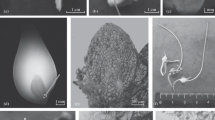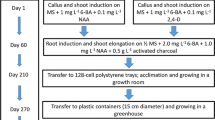Abstract
Highly inbred B line of cucumber was used to compare the effect of four types of in vitro culture on somaclonal variation. The plants were regenerated from the following types of culture: twelve- and eighteen-month-old liquid culture of meristematic clumps (LMC12(18)), ten-month-old embryogenic cytokinin-dependent suspension (CDS), eighteen-month-old embryogenic cytokinin-dependent suspension in medium with modified NH+ 4/NO3 - ratio (CDS 1.7), twelve-month-old embryogenic auxin-dependent suspension (ADS), thirty six-month-old embryogenic auxin-dependent suspension in medium with modified NH+ 4/NO3 - ratio (ADS 1.7) and recurrent leaf callus regeneration (RLC) – repeated 5 times. The differences in the incidence of the following properties were observed: the ploidy of R0 plants, the segregation of new morphological traits in R1 and the germination ability of R1 seeds. R1 families with the segregation of new phenotypes were most numerous in CDS (62.5%) and LMC18 (57.9%), next in CDS1.7 (35.7%), while the smallest number was found in LMC12 (11.1%) and RLC (3.4%).Tetraploid and mixoploid plants occurred in ADS1.7 and ADS (100%) whereas CDS and RLC were observed to contain only tetraploids, respectively 33.3% and 55.2%. There were no changes of ploidy after LMC12, LMC18 and CDS1.7. Among new phenotypes there were such that have not been described so far in cucumber: ginkgolike leaf (gll), yellow-green chlorophyll mutants (y-gc), serrate margin of corolla in male and female flowers (smc).
Similar content being viewed by others
References
Burza, W. & S. Malepszy, 1995. Direct plant regeneration from leaf explants in cucumber is free of stable genetic variation. Plant Breed 114: 341–345.
Burza, W., S. Malepszy & E. Rostek, 1996. The effect of simple and recurrent in vitro regeneration on a cucumber inbred line under field cultivation. Horticultural Science – Kertészeti Tudomány 28 1–2): 11–13 (Hungary).
Burza, W. & S. Malepszy, 1998. Cytokinin control of cucumber (Cucumis sativus L.) somatic embryogenesis. Abstracts of IX International Congress on Plant Tissue and Cell Culture. Jerusalem, Israel, June 14–19, p. 68.
Colijn-Hooymans, C.M., J.C. Hakkert, J. Jansen & J.B.M. Custers, 1994. Competence for regeneration of cucumber cotyledons is restricted to specific developmental stages. Pl Cell Tiss Org Cult 39: 211–217.
Creemers-Molenaar, J., J.P.M. Loeffen, M. van Rossum & C.M. Colijn-Hooymans,1992. The effect of genotype, cold storage and ploidy level on the morphogenic response of perennial ryegrass (Lolium perenne L.) suspension cultures. Plant Sci 83: 87–94.
Custers, J.B.M., S. Zijlstra & J. Jansen, 1990. Somaclonal variation in cucumber (Cucumis sativus L.) plants regenerated via embryogenesis. Acta Bot Neerl 39(2): 153–161.
De Paepe, R., D. Bleton & F. Gnangble, 1981. Basis and extent of genetic variability among doubled haploid plants obtained by pollen culture in Nicotiana sylvestris. Theor Appl Genet 59: 177–184.
Doležel, J., S. Lucretti & F.J. Novak, 1987. The influence of 2,4-dichlorophenoxyacetic acid on cell cycle kinetics and sisterchromatid exchange frequency in garlic (Allium sativum) meristem cells. Biol Plant (Prague) 29: 253–257.
Faris, N.M., W. Burza, S. Malepszy & K. Niemirowicz-Szczytt, 1997. Direct regeneration from leaf explants of cucumber (Cucumis sativus L.) haploid. Mat. VIII Ogólnopolsk. Konf. Polskiej Sekcji Kultur in vitro PTB 'Roslinne kultury in vitro w badaniach podstawowych i stosowanych.' Kraków, Poland, Aug. 25–27, pp. 249–252.
Fujishige, I., R. Tanaka & K. Taniguchi, 1996. Efficient isolation of non-chimeric tetraploids artificially induced in a stable culture of Haplopappus gracilis. Theor Appl Genet 92: 157–162.
Geier, T., A. Beck & W. Preil, 1992. High uniformity of plants regenerated from cytogenetically variable embryogenic suspension cultures of Poinsettia (Euphorbia pulcherrima Willd. Ex Klotzsch). Plant Cell Rep 11: 150–154.
Gilissen, L.J.W., M.J. van Staveren, J. Creemers-Molenaar & H.A. Verhoeven, 1993. Development of polysomaty in seedlings and plants of Cucumis sativus L. Plant Sci 91: 171–179.
Lilly, J.W., G. Bartoszewski, S. Malepszy & M.J. Harvey, 2001. A major deletion in the cucumber mitochondrial genome sorts with the MSC phenotype.
Karp, A., 1991. On the current understanding of somaclonal variation. Oxford Surv Pl Mol Cell Biol 7: 1–58.
Karp, A., 1995. Somaclonal variation as a tool for crop improvement. Euphytica 85: 295–302.
Kim, S.G., J.R. Chang, H.C. Cha & K.W. Lee, 1988. Callus growth and plant regeneration in diverse cultivars of cucumber (Cucumis sativus L.). Pl Cell Tiss Org Cult 12: 67–74.
Kondo, K., S. Nadamitsu, R. Tanaka & K. Taniguchi, 1991. Micropropagation of Spinacia oleracea L. through culture of shoot primodia. Plant Tiss Cult Lett 8(1): 1–4.
Kreuger, M., E. Postma, Y. Brouwer & G.-J. van Holst, 1995. Somatic embryogenesis of Cyclamen persicum in liquid medium. Physiol Plant 94: 605–612.
Kreuger, M., W. van der Meer, E. Postma, R. Abbestee, N. Raaijmakers & G.-J. van Holst, 1996. Genetically stable cell lines of cucumber for the large-scale production of diploid somatic embryos. Physiologia Plantarum 97: 303–310.
Kubaláková, M., J. Doležel & A. Lebeda, 1996. Ploidy instability of embryogenic cucumber (Cucumis sativus L.) callus culture. Biologia Plantarum 38(3): 475–480.
Larkin, P.J. & W.R. Scowcroft, 1981. Somaclonal variation – a novel source of variability from cell cultures for plant improvement. Theor Appl Genet 60: 197–214.
?ady?zy´nski, M., A. Korzeniewska & S. Malepszy, 2001. Recurrent regeneration through somatic embryogenesis reduces yield in cucumber. HortScience 36(5): 987.
Malepszy, S., de J. Grunewaldt & M. Maluszynski, 1977. Uber die selektion von Mutanten in Zellkulturen aus haploider Nicotiana silvestris Spegazz. et Comes. Z Pflanzenz 79: 160–166.
Malepszy, S. & A. Nadolska-Orczyk, 1989. In vitro culture of Cucumis sativus VIII. Variation in the progeny of phenotypically not altered R1 plants. Plant Breed 102: 66–72.
Malepszy, S., W. Burza & M. Smiech, 1996. Characterization of a cucumber (Cucumis sativus L.) somaclonal variant with paternal inheritance. J Appl Genet 37(1): 65–78.
May, R.A. & K.C. Sink, 1995. Genotype and auxin influence direct somatic embryogenesis from protoplasts derived from embryogenic cell suspensions of Asparagus officinalis L. Plant Sci 108: 71–84.
Murashige, T. & F. Skoog, 1962. A revised medium for rapid growth and bioassays with tobacco tissue cultures. Physiol Plant 15: 473–495.
Murata, M., 1989. Effects of auxin and cytokinin on induction of sister chromatid exchanges in cultured cells of wheat (Triticum aestivum L.). Theor Appl Genet 78: 521–524
Nadolska-Orczyk, A., S. Malepszy & S. Belz, 1989. Effect of recurrent in vitro culture on somaclonal variation. XII Eucarpia Congress, Vorträge für Pflanzenzüchtung, pp. 26–1.
Pierce, L.K. & T.C. Wehner, 1990. Review of genes and linkage groups in cucumber. HortScience 25(6): 605–615.
Pl¸ader, W., S. Malepszy, W. Burza & Z. Rusinowski, 1998. The relationship between the regeneration system and genetic variability in the cucumber (Cucumis sativus L.). Euphytica 103: 9–15.
Tanaka, R., K. Taniguchi, H. Miyagawa, I. Fujishige & H. Ikeda, 1988. Stock of chromosome-types and tissue cultured shoot primordium (in Japanese with English summary). J Pharm Soc Jpn 108: 1023–1039.
Wróblewski, T., M. Filipecki & S. Malepszy, 1995. Factor influencing cucumber (Cucumis sativus L.) somatic embryogenesis. I. The crucial role of pH and nitrogen in suspension cuclture. Acta Soc Bot Pol 64(3): 223–231.
Author information
Authors and Affiliations
Rights and permissions
About this article
Cite this article
Ładyżyński, M., Burza, W. & Malepszy, S. Relationship between somaclonal variation and type of culture in cucumber. Euphytica 125, 349–356 (2002). https://doi.org/10.1023/A:1016017825907
Issue Date:
DOI: https://doi.org/10.1023/A:1016017825907




